

Loop quantum gravity. More precisely, space can be viewed as an extremely fine fabric or network "woven" of finite loops. These networks of loops are called spin networks. Black Hole Cores May Not Be Infinitely Dense. The cores of black holes may not hold points of infinite density as currently thought, but portals to elsewhere in the universe, theoretical physicists say.
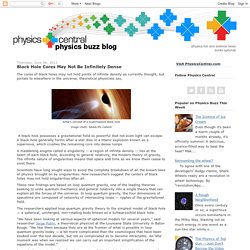
A black hole possesses a gravitational field so powerful that not even light can escape. New? Start Here. Hi, and welcome to my site “Of Particular Significance”.

If you are an interested layperson, whether you have very little knowledge of science or quite a lot already, this website is mainly intended for you — although as you’ll see, it has a number of scientists among its readers. It’s still young and growing, so check back often for new material. You’ll see there’s a blog with up-to-date comments, but most of the web-pages are permanent or semi-permanent articles.
Many of them are pedagogical and aimed at helping you get some of your questions answered. Topics range from particle physics (the heart of the website) to general musings about science and related topics. To step your way through the website from the beginning, click here to go to my “About this site and how to use it” page. Like this: Like Loading... Why one Higgs boson will not be enough. On Tuesday, scientists announced promising signs in the data from the Large Hadron Collider (LHC) near Geneva of the existence of the Higgs boson.

If the discovery is confirmed with new data, what will it mean for physics and why should we care? First, the short answer. If the Higgs is discovered, it will represent perhaps one of the greatest triumphs of the human intellect in recent memory, vindicating 50 years spent building one of the greatest theoretical edifices in all of science and requiring the construction of the most complicated machine that has ever been made.
That's the good news. But if the Higgs is all that is found at the LHC, it will mean that the other crucial empirical guidance that physicists now need to try and understand truly fundamental questions about our existence – from understanding whether all four forces in nature are unified in some grand theory, to determining what may have caused the big bang – will still be absent. The Accelerating Universe and Dark Energy Might Be Illusions. In 1929, cosmologists discovered that the universe is expanding that space-time, the fabric of the cosmos, is stretching.
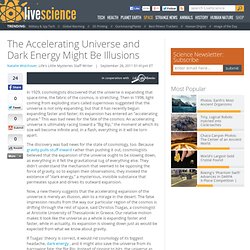
Then in 1998, light coming from exploding stars called supernovas suggested that the universe is not only expanding, but that it has recently begun expanding faster and faster; its expansion has entered an "accelerating phase. " Dark Matter: Just Fine, Thanks. Astrophysical ambulance-chasers everywhere got a bit excited this week, and why wouldn’t they?

Here are some of the headlines we read: Wow. More evidence against dark matter? I didn’t know about the original evidence. Sadly (and I mean that — see below) there is no evidence against dark matter here. I’m the first person to defend journalists against unfair attacks, and we all know that headlines are usually not written by the people who write the actual articles. McGaugh’s new paper doesn’t give any evidence at all against dark matter. It’s obvious what happens here. But let me take this opportunity to lay out the problems with MOND. Which is an important point, because MOND is not true. Does This Ontological Commitment Make Me Look Fat? Floating Gyroscopes Vindicate Einstein. Four superconducting pingpong balls floating in space have just confirmed two key predictions of Einstein’s general theory of relativity, physicists announced in a press conference Wednesday.

“We have completed this landmark experiment testing Einstein’s universe, and Einstein survives,” said physicist Francis Everitt of Stanford University, the principal investigator on NASA’s Gravity Probe B mission. The probe, which launched in 2004, was designed to test the effect Earth’s gravity has on the space-time around it. According to Einstein, the Earth warps its local space-time like a bowling ball sitting on a trampoline, a phenomenon called the geodetic effect. This effect means that a circle of fabric with the Earth’s circumference, about 24,900 miles, would be pulled into a shallow cone with a circumference 1.1 inches shorter. Scientists release most accurate simulation of the universe to date. The Bolshoi supercomputer simulation, the most accurate and detailed large cosmological simulation run to date, gives physicists and astronomers a powerful new tool for understanding such cosmic mysteries as galaxy formation, dark matter, and dark energy.
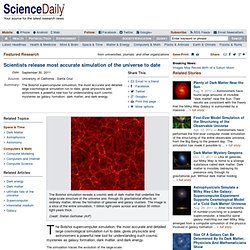
The simulation traces the evolution of the large-scale structure of the universe, including the evolution and distribution of the dark matter halos in which galaxies coalesced and grew. Initial studies show good agreement between the simulation's predictions and astronomers' observations. "In one sense, you might think the initial results are a little boring, because they basically show that our standard cosmological model works," said Joel Primack, distinguished professor of physics at the University of California, Santa Cruz.
Beyond space-time: Welcome to phase space - space - 08 August 2011. Read full article Continue reading page |1|2|3 A theory of reality beyond Einstein's universe is taking shape – and a mysterious cosmic signal could soon fill in the blanks IT WASN'T so long ago we thought space and time were the absolute and unchanging scaffolding of the universe.
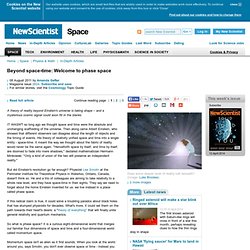
Then along came Albert Einstein, who showed that different observers can disagree about the length of objects and the timing of events. His theory of relativity unified space and time into a single entity - space-time. But did Einstein's revolution go far enough? If this radical claim is true, it could solve a troubling paradox about black holes that has stumped physicists for decades.
So what is phase space? Momentum space isn't as alien as it first sounds. A glimpse of the (almost) impossible... The universe is littered with the weird and wonderful and GRB 060614 could turn out to be one of the weirdest and most wonderful of them all.

GRB 060614, which we’ll call Ralph to smooth things along, was a gamma-ray burst with some very puzzling properties detected by Nasa’s Swift satellite on June 14, 2006. Gamma-ray bursts are the most powerful explosions in the universe. They usually come in two flavours: long bursts, which are normally caused by the sudden release of energy that occurs when a collapsing star forms a black hole in a massive supernova event, and short bursts, which occur when two neutron stars – the superdense remains of dead stars – collide.
[Image above: GRB 060614 is a strange gamma-ray burst detected by Nasa’s Swift satellite on June 14, 2006. It originated in a galaxy 1.6billion light years away and didn’t fit in with any of the existing models for gamma-ray burst creation. Ralph’s gamma ray burst lasted 102 seconds, which put it firmly in the long burst camp. What Happened Before the Big Bang? The New Philosophy of Cosmology - Technology. What existed before the big bang?
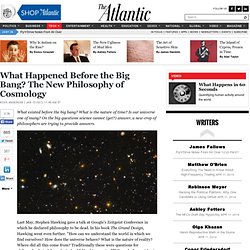
What is the nature of time? Is our universe one of many? On the big questions science cannot (yet?) Answer, a new crop of philosophers are trying to provide answers. Last May, Stephen Hawking gave a talk at Google's Zeitgeist Conference in which he declared philosophy to be dead. Sean Carroll: Distant time and the hint of a multiverse. A Step-by-Step Guide to Cosmology’s Best-Kept Secret. How far is each of these galaxies? Appearances may deceive. In my previous post, I described the little-known and somewhat counterintuitive idea that objects in the distant universe appear larger and larger the farther they are, in a reversal of the usual rules of perspective. I called it the cosmic magnifying lens. As promised, I will now explain the physics behind it. The Beginning of the Universe and the Limit of Knowledge. “Despite its name, the big bang theory is not really a theory of a bang at all.
It is really only a theory of the aftermath of a bang.” -Alan Guth So you finally understand it. 'A Universe From Nothing' by Lawrence Krauss, AAI 2009. A Lenticular Galaxy Reveals Spinning Black Holes. In the heart of MCG-6-30-15, a galaxy 130 million light-years away, there is a hole. It’s as big around as the orbit of Mars. Into this hole stars and star stuff are always falling—a lot of stuff, the equivalent of a hundred million suns so far. From this hole nothing escapes, not even light. It is perfectly black, like the mouth of a long tunnel. If you were to get into a spaceship and put it into orbit around this perfect blackness, you would find, once you got close enough, and even before you started your final descent into darkness, that you were no longer in control.